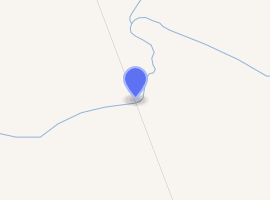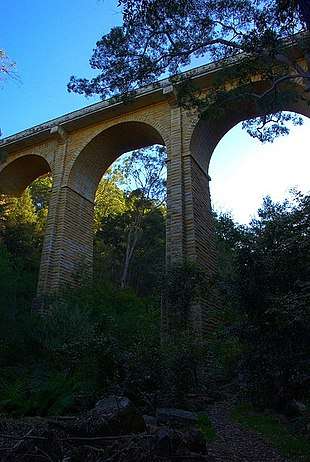Wyaldra Creek railway bridge, Gulgong
The Wyaldra Creek railway bridge is a heritage-listed former railway bridge that carried the Gwabegar railway line across the Wyaldra Creek at Gulgong, in the Mid-Western Regional Council local government area of New South Wales, Australia. The property was owned by RailCorp, an agency of the Government of New South Wales. It was added to the New South Wales State Heritage Register on 2 April 1999.[1]
Wyaldra Creek railway bridge (former) | |
|---|---|
.jpg) Heritage boundaries | |
 Location in New South Wales | |
| Coordinates | 32°19′49″S 149°30′59″E |
| Carries | Gwabegar railway line |
| Crosses | Wyaldra Creek |
| Locale | Gulgong, Mid-Western Regional Council, New South Wales, Australia |
| Official name | Gulgong railway bridge over Wialdra Creek |
| Owner | RailCorp |
| Characteristics | |
| Longest span | 12.2 metres (40 ft) |
| No. of spans | 3 |
| Rail characteristics | |
| No. of tracks | One |
| Track gauge | 4 ft 8 1⁄2 in (1,435 mm) standard gauge |
| History | |
| Construction end | December 1909 |
| Opened | December 1910 |
| Collapsed | 1987 (demolished) |
| Official name | Gulgong railway bridge over Wialdra Creek |
| Type | State heritage (built) |
| Designated | 2 April 1999 |
| Reference no. | 1038 |
| Type | Railway Bridge/ Viaduct |
| Category | Transport - Rail |

| |
The bridge was demolished in 1987.[2]
History
The bridge was built in 1909 as part of the extension of the railway from Gulgong to Dunedoo. The construction of the bridge was reported to be the main challenge for the contractors building the extension.[3] Numerous difficulties were experienced sinking the bridge cylinders "through the drift sand to a very hard and uneven basalt at the bottom of the creek", and progress was slow, but it was completed by December 1909.[4] The Dunedoo extension was formally opened in December 1910.[5]
Description
The bridge carried a single-track 4 ft 8 1⁄2 in (1,435 mm) standard gauge railway on an open deck (with transomes). It spans were 4.3 metres (14 ft), 7.3 metres (24 ft), three at 12.2 metres (40 ft), 7.3 metres (24 ft) and 4.3 metres (14 ft). The four shorter approach spans were timber girders. The three 12.2 metres (40 ft) spans were timber trusses of the Howe-type with timber compression diagonals, vertical tension rods and six bays. The piers were timber on concrete bases; at least some of the piers were sheeted.[2]
The bridge was demolished in 1987.[2]
Heritage listing
The Wyaldra Creek railway bridge was listed on the New South Wales State Heritage Register on 2 April 1999.[1]
See also
- List of railway bridges in New South Wales
References
- "Gulgong railway bridge over Wialdra Creek". New South Wales State Heritage Register. Office of Environment and Heritage. H01038. Retrieved 2 June 2018.
- "Wialdra Creek Rail Bridge, Gulgong, NSW, Australia (Place ID 15907)". Australian Heritage Database. Department of the Environment. Retrieved 30 April 2020.
- "THE DUNEDOO RAILWAY". Evening News (13, 166). New South Wales, Australia. 20 August 1909. p. 10. Retrieved 21 July 2018 – via National Library of Australia.
- "GULGONG-DUNEDOO RAILWAY". The Farmer and Settler. IV (48). New South Wales, Australia. 31 December 1909. p. 7. Retrieved 21 July 2018 – via National Library of Australia.
- "BREVITIES". Evening News (13, 563). New South Wales, Australia. 28 November 1910. p. 1. Retrieved 21 July 2018 – via National Library of Australia.
Attribution
![]()
External links
![]()
